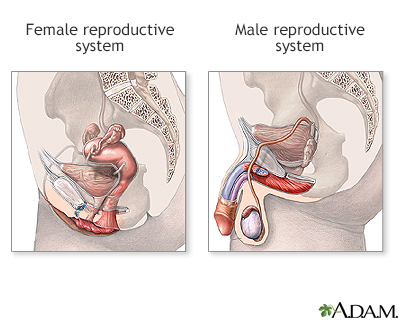Precocious puberty
Pubertas praecox
Puberty is the time when a person's sexual and physical characteristics mature. Precocious puberty is when these body changes happen earlier than normal.
Images


I Would Like to Learn About:
Causes
Puberty usually begins between ages 8 and 13 for girls and ages 9 and 14 for boys.
The exact age a child enters puberty depends on a number of factors, including family history, nutrition, and sex.
Most often there is no clear cause for precocious puberty. Some cases are due to changes in the brain, genetic problems or certain tumors that release hormones. These conditions include:
- Disorders of the testicles, ovaries, or adrenal glands
- Tumor of the hypothalamus (hypothalamic hamartoma)
- Tumors that release a hormone called human chorionic gonadotropin (hCG)
Symptoms
In girls, precocious puberty is when any of the following develop before age 8:
- Armpit or pubic hair
- Beginning to grow faster
- Breasts
- First period (menstruation)
- Mature outer genitals
In boys, precocious puberty is when any of the following develop before age 9:
- Armpit or pubic hair
- Growth of the testes and penis
- Facial hair, often first on the upper lip
- Muscle growth
- Voice change (deepening)
Exams and Tests
Your health care provider will perform a physical exam to check for signs of precocious puberty.
Tests that may be ordered include:
- Blood tests to check hormone levels.
- CT or MRI scan of the brain or of the abdomen to check for tumors.
Treatment
Depending on the cause, treatment for precocious puberty may include:
- Medicines to stop the release of sexual hormones, to help delay puberty. These medicines are given as a shot (injection). They will be given until the normal age of puberty.
- Surgery to remove a tumor.
Children with early sexual development may have psychological and social problems. Children and adolescents want to be the same as their peers. Early sexual development can make them appear different. Parents can support their child by explaining the condition and how their provider plans to treat it. Talking to a mental health worker or counselor may also help.
Possible Complications
Children who go through puberty too early may not reach their full height because growth stops too early.
When to Contact a Medical Professional
See your child's provider if:
- Your child shows signs of precocious puberty
- Any child with early sexual development appears to be having problems in school or with peers
Prevention
Adult prescription medicines and dietary supplements that contain hormones should not be consumed by children.
Your child should maintain a healthy weight.
References
Cooke DW, DiVall SA, Radovick S. Normal and aberrant growth in children. In: Melmed S, Auchus RJ, Goldfine AB, Koenig RJ, Rosen CJ, eds. Williams Textbook of Endocrinology. 14th ed. Philadelphia, PA: Elsevier; 2020:chap 25.
Garibaldi LR, Chemaitilly W. Disorders of pubertal development. In: Kliegman RM, St. Geme JW, Blum NJ, Shah SS, Tasker RC, Wilson KM, eds. Nelson Textbook of Pediatrics. 21st ed. Philadelphia, PA: Elsevier; 2020:chap 578.
BACK TO TOPReview Date: 8/5/2023
Reviewed By: Neil K. Kaneshiro, MD, MHA, Clinical Professor of Pediatrics, University of Washington School of Medicine, Seattle, WA. Also reviewed by David C. Dugdale, MD, Medical Director, Brenda Conaway, Editorial Director, and the A.D.A.M. Editorial team.

Health Content Provider
06/01/2025
|
A.D.A.M., Inc. is accredited by URAC, for Health Content Provider (www.urac.org). URAC's accreditation program is an independent audit to verify that A.D.A.M. follows rigorous standards of quality and accountability. A.D.A.M. is among the first to achieve this important distinction for online health information and services. Learn more about A.D.A.M.'s editorial policy, editorial process and privacy policy. A.D.A.M. is also a founding member of Hi-Ethics. This site complied with the HONcode standard for trustworthy health information from 1995 to 2022, after which HON (Health On the Net, a not-for-profit organization that promoted transparent and reliable health information online) was discontinued. |
The information provided herein should not be used during any medical emergency or for the diagnosis or treatment of any medical condition. A licensed medical professional should be consulted for diagnosis and treatment of any and all medical conditions. Links to other sites are provided for information only -- they do not constitute endorsements of those other sites. © 1997- 2025 A.D.A.M., a business unit of Ebix, Inc. Any duplication or distribution of the information contained herein is strictly prohibited.
